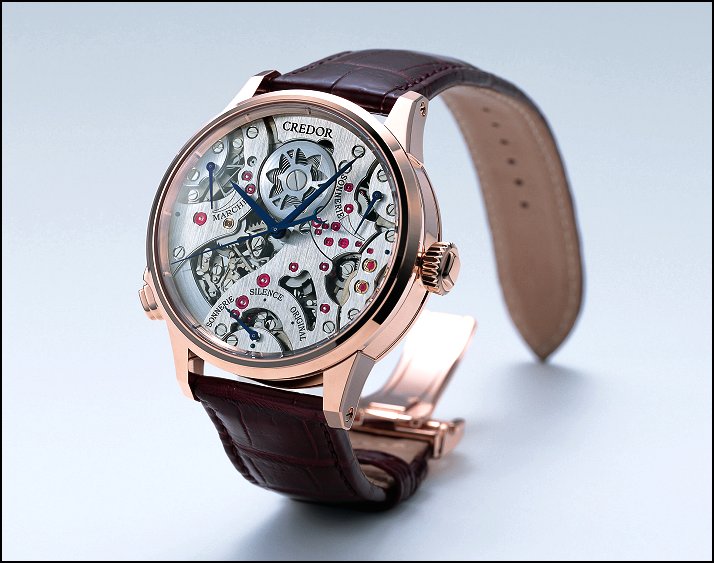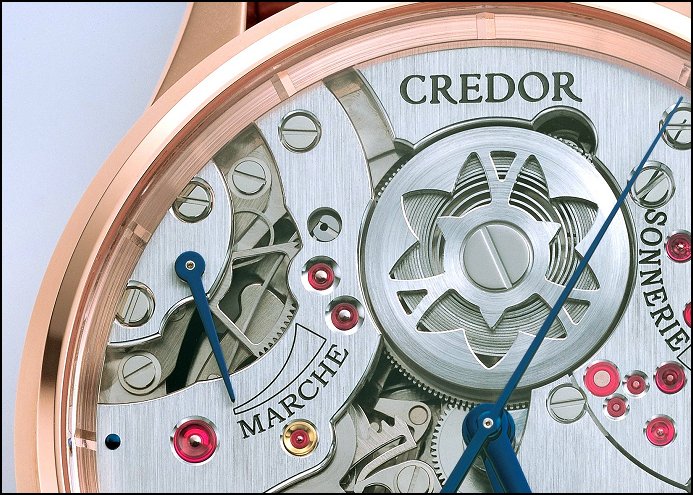|
Thursday 30th March, 2006
The Credor Spring Drive Sonnerie
Since its foundation in 1881, SEIKO’s history has been a history of challenges: challenges identified, challenges addressed and challenges met. For over 100 years, SEIKO has risen to these challenges and has thereby created some truly remarkable timepieces.
The 2006 Baselworld exhibition witnesses the premiere of another landmark timepiece, the Credor Spring Drive Sonnerie. The challenge followed naturally from the success of Spring Drive, a watch that presents, visually, the pure, natural and continuous motion of time. Could this new visual representation of the calm, pure passage of time be expressed in sound as well as by the smooth movement of the hands across the dial. The challenge was taken up by a small and elite team of watch making craftsmen in SEIKO Epson under the leadership of Mr. Kenji Shiohara*. This team, “the Micro Artist Studio*,” is guided by a shared passion for the creation of distinctively Japanese timepieces which express both the technical skill of SEIKO and the cultural heritage of Japan. The result is a unique and hugely innovative timepiece which conveys to both eye and ear the serene flow of time. The continuous stream of each second, minute and hour is indicated by the quiet revolution of the glide-motion hands around the dial, and the time is also marked by a unique chime expressed in a softly tinkling “hanging” bell. This bell chime resonates with the cultural heritage of Japan and is instantly recognizable as an auditory symbol of the nation’s centuries of tradition.
The Spring Drive Movement The watch is built on the base of the ground-breaking Spring Drive movement 7R series with its glide-motion hands and 48 hour power reserve. Onto this Spring Drive movement is added the “sonnerie” mechanism which has its own, entirely separate barrel, ensuring that this mechanism has more than 40 hours of power reserve. The power reserve is shown on a second indicator at the two o’clock position. The movement is easy to operate with just the one crown at the 3 o’clock position and a mode indicator at 6 o’clock. The movement comprises over 600 individual parts, each uniquely made and, of course, hand assembled and finished to the highest levels of precision.
The Hour Striking Function The “sonnerie” mechanism has an hour striking function. It is built around typical Japanese hanging bell sound. This was chosen because its unique and lingering sound harmonizes with the natural flow of time and space. Purity of sound was the greatest challenge, and the achievement of the perfect bell sound was made possible by the remarkable combination of a bell system, the use of a newly developed governor and the unique sound escape system that allows the chime sound to pass through the case. This governor mechanism is a remarkable innovation. It uses the viscosity of air so that the chime sounds at very precise intervals and there is no other sound to interfere with the pure strike of the bell. Combined with the entirely silent Tri-synchro regulator, the absolute silence of the whole movement is ensured and the complete purity of the sound is the delightful result. The hour striking function can be set to one of three different modes: an hourly strike, three hourly strike, or silence. To power the hour striking function, a spring exclusive to this mechanism is used in parallel with the watch mechanism’s barrel. The hour repeating function announces the current time by chiming each hour when the button located at the 8 o’clock position is pressed. A silent function is included so that chiming can be muted as long as the button located at 8 o’clock position is pressed halfway down. The movement has a “fail-safe” mechanism to prevent the chime sounding when inappropriate actions are performed by mistake.
The Modes The mechanism offers the following three modes: 1. “Sonnerie” mode: the number of hours is automatically counted by chiming every hour on the hour. 2. “Original” mode: the time is announced by a three-strike chime at the passing of every three hours: 12:00, 3:00, 6:00, and 9:00. 3. “Silent” mode: the chime is disengaged. These modes can be selected simply by changing the mode indicator.
The Design As befits a watch of such intricacy and sophistication, the strike hammer is visible through the dual surface curved sapphire crystal. The case itself is crafted from 18-karat pink gold, which not only reflects the value of the movement but assists the purity of the sound of the chime. On the mainspring barrel of the bell mechanism, a cutout Japanese bellflower (Kikyo flower in Japanese) drifts down on a river, symbolizing the continuous flow of time. The Japanese bellflower is chosen because it is the flower of the city where the Micro Artist Studio is located.
The Purity of Perfection
The Credor Spring Drive Sonnerie brings
purity of sound and purity of motion together in a remarkable unison of
perfection in engineering craftsmanship. The Micro Artist Studio proudly
presents its latest creation to the world. Just five of these timepieces
will be created in 2006. Credor Spring Drive Sonnerie Launch Credor Spring Drive Sonnerie will be sold directly to customers from SEIKO Watch Corporation with the exception of Japan and the East Asian region. Shipment will also be made directly at the time and by the method of the customer’s choosing. The retail price will be 15 million Japanese Yen plus VAT and import duty. (equivalent to Euro 107,142 at the rate of Euro/Yen=140). The very first production timepiece for the international market will be available at the SEIKO Center in Paris in November for private viewing by appointment. Further details of the product and the order placement will be posted in May on our websites www.seikowatches.com and www.seikospringdrive.com.
Notes: The Micro Artist Studio Set up in 2000, the mission of this studio is the development of luxury watches which convey the heritage of SEIKO and the watch industry to the coming generations. Credor Spring Drive Sonnerie has been developed by eight elite experts in Micro Artist Studio of SEIKO Epson since the autumn of 2003. They are, needless to say, the most highly qualified, skilled and experienced watch-makers within SEIKO Epson. Kenji Shiohara A watch technician who won first prize at the 25th World Skills Competition in 1979, was honored as a “Contemporary Master Craftsman” in 2003, and received a Medal with Yellow Ribbon by the Japanese Government among medals of honor in the autumn of 2005.
Specifications:
Caliber Details:
The above specifications, which are as announced in March 2006, may differ from the actual product specifications.
|

